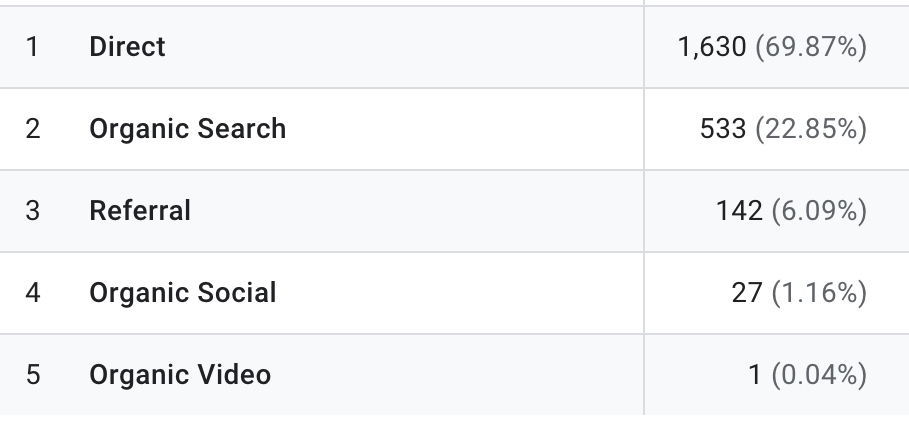
Google Analytics provides an overwhelming amount of data about your website visitors, but not all metrics are equally valuable for small businesses. The key to leveraging analytics effectively is focusing on metrics that directly inform business decisions and help you understand whether your website is meeting its goals.
This guide will help you identify and understand the Google Analytics metrics that matter most for small business websites, moving beyond vanity metrics to data that drives real improvements in your online presence and revenue.
Understanding the Difference Between Metrics and Insights
Before diving into specific metrics, it’s important to understand that raw numbers alone don’t tell the complete story. A metric becomes meaningful when you understand what it reveals about visitor behavior and how it connects to your business objectives.
For example, knowing you had 1,000 website visitors last month is a metric. Understanding that 60% of those visitors came from mobile devices, spent an average of three minutes on your services page, and 5% requested quotes is the insight that helps you make decisions.
Always ask yourself: “What action can I take based on this information?” If a metric doesn’t lead to potential action or better understanding, it’s probably not worth monitoring closely.
Traffic Sources: Understanding Where Visitors Come From
One of the most valuable sections in Google Analytics is the traffic sources report, which shows how people are finding your website. This information helps you understand which marketing efforts are working and where to focus future resources.

Organic Search Traffic Visitors arriving from search engines like Google represent people actively looking for services or information you provide. High organic traffic indicates strong search engine optimization and relevant content.
Pay attention to which keywords and phrases bring organic traffic. This reveals what problems or services potential customers are searching for, helping you refine your content strategy and service offerings.
If organic traffic is low or declining, it may indicate technical SEO issues, strong competition, or a need for better content optimization.
Direct Traffic Direct traffic includes visitors who type your web address directly into their browser or click from bookmarked links. This typically represents people already familiar with your business from offline marketing, word-of-mouth referrals, or previous visits.
Growing direct traffic often indicates increasing brand awareness and customer loyalty. However, some direct traffic actually comes from untracked sources, so interpret this metric alongside other indicators.
Referral Traffic Referral traffic comes from links on other websites, including business directories, review sites, partner websites, and social media platforms. High-quality referral traffic from relevant websites can bring well-qualified potential customers.
Identify your top referral sources and consider strengthening those relationships or pursuing similar opportunities. If you’re listed in business directories, ensure your information is accurate and complete.
Social Media Traffic Traffic from social platforms shows how effectively your social media presence drives website visits. Compare traffic levels from different platforms to identify where your audience is most active and engaged.
Remember that social media metrics should align with your overall business goals. High social traffic that doesn’t convert into customers or leads may indicate a mismatch between your social audience and your target customers.
User Engagement Metrics: Understanding Visitor Behavior
Engagement metrics reveal how visitors interact with your website once they arrive, providing insights into content effectiveness and user experience quality.
Session Duration
Average session duration shows how long visitors typically spend on your website. Longer sessions generally indicate engaged visitors finding valuable content, though the ideal duration varies by business type and page purpose.
For service businesses, longer sessions on informational pages suggest visitors are thoroughly researching your services. For e-commerce sites, you want enough time for browsing and purchasing but not so long that it indicates confusion or difficulty completing purchases.
Very short session durations across most pages might indicate poor content quality, slow loading times, or a mismatch between visitor expectations and your actual content.
Pages Per Session
This metric shows the average number of pages visitors view during a single session. Multiple page views often indicate engaged visitors exploring your services, products, or content.
Low pages per session might suggest visitors aren’t finding what they need, your navigation is unclear, or your internal linking structure needs improvement.
For small business websites, aim for at least 2-3 pages per session. Visitors should move from entry pages to service details, about pages, or contact information.
Adding Pages Per Session to GA4 Reports
In GA4, the equivalent metric is called “Views per session” or “Pages per session.” To add it to your reports, click the pencil icon to customize the report, select “Metrics” in the right panel, click “Add metric,” and search for “Views per session” or “Pages per session.” Select it from the list and click “Apply.” Like bounce rate, you’ll need to add this metric to each report where you want to see it, as it’s not included in the default GA4 report configurations.
Bounce Rate
Bounce rate shows the percentage of visitors who leave after viewing only one page. High bounce rates aren’t always bad—they depend on page purpose and content type.
A high bounce rate on blog posts might be acceptable if visitors found the information they needed. However, high bounce rates on your homepage or key service pages typically indicate problems with content relevance, page design, loading speed, or user experience. This is when you want to evaluate those pages and start to consider making changes to reduce the bounce rate on those pages.
Examine bounce rates by page and traffic source. Different pages and visitor sources naturally have different engagement patterns.
Adding Bounce Rate to GA4 Reports
In Google Analytics 4 (GA4), you’ll notice that bounce rate isn’t displayed by default in most reports. To add it, navigate to any report where you want to see bounce rate, click the pencil icon (customize report) in the top right corner, then click “Metrics” in the right panel. Click “Add metric” and search for “Bounce rate” in the metric list. Select it and click “Apply” to save your customized report. The bounce rate will now appear as a column in that report. You’ll need to add it separately to each report where you want to see it, as GA4 doesn’t include it automatically like Universal Analytics did.
Conversion Metrics: Measuring Business Results
Conversion metrics directly measure how well your website achieves its business objectives, making them the most important metrics for demonstrating ROI.
Goal Completions
Google Analytics allows you to set up goals representing important visitor actions like form submissions, phone calls, purchases, or specific page views. Goal completion data shows how effectively your website converts visitors into leads or customers.
Common goals for small businesses include:
- Contact form submissions
- Phone number clicks (on mobile devices)
- Online purchases or bookings
- Newsletter signups
- Specific page visits (like pricing or services pages)
Track multiple goals to understand the full range of valuable actions visitors take on your site.
Conversion Rate
Your conversion rate divides goal completions by total visitors, showing the percentage of visitors who take desired actions. This metric reveals how effectively your website turns traffic into business results.
A 2-5% conversion rate is typical for many small business websites, though this varies significantly by industry, traffic source, and what you’re measuring. Focus on improving your own conversion rate over time rather than comparing to industry averages.
Low conversion rates despite healthy traffic suggest issues with your value proposition, call-to-action clarity, trust signals, or the user experience itself.
Conversion Rate by Traffic Source
Examining conversion rates by traffic source reveals which marketing channels bring the most qualified visitors. Some sources might drive high traffic but low conversions, while others bring fewer visitors who convert at higher rates.
This insight helps you allocate marketing resources more effectively. A source bringing 100 visitors with a 10% conversion rate is more valuable than one bringing 1,000 visitors with a 0.5% conversion rate.
Page Performance Metrics: Identifying Top Content
Understanding which pages perform well helps you replicate success and identify improvement opportunities.
Top Landing Pages
Landing pages are where visitors first enter your website. Your top landing pages reveal what content attracts the most interest and which pages make the strongest first impressions.
Optimize your top landing pages carefully since they disproportionately impact overall website performance. Ensure they have clear calls-to-action, compelling content, and intuitive navigation to key pages.
Exit Pages
Exit pages show where visitors most commonly leave your website. High exit rates on thank-you pages or confirmation pages are expected and positive. However, high exit rates on key conversion pages suggest problems preventing visitors from completing desired actions.
Investigate pages with unexpectedly high exit rates for issues like broken forms, unclear next steps, or content that fails to maintain engagement.
Page Value
For websites with e-commerce tracking or goal values assigned, page value shows the average value generated by each page. This reveals which content contributes most to your business objectives, even if it’s not directly involved in conversions.
High page value for blog posts or informational pages indicates they play important roles in moving visitors toward conversion, justifying continued content investment.
Audience Insights: Understanding Who Visits
Demographic and technology data help you understand your audience and ensure your website meets their needs.
Device Category
The breakdown between desktop, mobile, and tablet traffic reveals how visitors access your website. For most local businesses, mobile traffic often exceeds desktop, making mobile optimization critical.
Compare engagement and conversion metrics across device types. If mobile visitors have higher bounce rates or lower conversion rates, your mobile experience may need improvement.
Location Data
Geographic data shows where your visitors are located. For local businesses, most traffic should come from your service area. Traffic from distant locations might indicate SEO opportunities or confusion about your service area.
Use location data to identify expansion opportunities or underserved areas where increased marketing might be effective.
New vs. Returning Visitors
The balance between new and returning visitors provides insights about your marketing effectiveness and customer loyalty. Healthy websites typically see both new visitors (indicating effective marketing and discoverability) and returning visitors (showing value and relationship building).
A website with only new visitors might struggle with engagement or customer retention. Predominantly returning visitors might indicate limited marketing reach or growth potential.
Time-Based Trends: Identifying Patterns
Examining metrics over time reveals trends, seasonal patterns, and the impact of specific changes or marketing campaigns.
Week-Over-Week and Month-Over-Month Comparisons
Regular comparison of current performance to previous periods helps identify growth trends, seasonal variations, and unusual patterns requiring investigation.
Look for correlations between traffic changes and specific business activities, marketing campaigns, or external factors affecting your industry.
Day and Time Patterns
Understanding when visitors typically access your website helps you time content publication, social media posts, and even customer service availability for maximum impact.
Some businesses see different visitor behavior patterns on weekdays versus weekends. Use this information to tailor your approach and set realistic expectations for response times.
Putting Metrics Into Action
The real value of Google Analytics comes from using insights to improve your website and marketing. Create a regular review schedule—monthly for most small businesses—to examine key metrics and identify action items.
Document your findings and the actions you take based on analytics data. This creates a valuable record of what works for your specific business and helps you avoid repeating unsuccessful experiments.
Focus on one or two improvement areas at a time rather than trying to address everything simultaneously. Meaningful improvement comes from sustained attention to specific goals.
Remember that metrics should inform decisions, not make them. Combine analytics data with customer feedback, business intuition, and your understanding of your market to make well-rounded strategic choices.
Moving Beyond Vanity Metrics
Avoid getting distracted by metrics that look impressive but don’t connect to business objectives. Total page views, time on site averages, and even traffic volume matter less than whether those visitors take actions that benefit your business.
The most meaningful metrics answer questions like: Are we attracting the right visitors? Is our website effectively converting visitors into customers? Which marketing efforts provide the best return on investment? Where should we focus improvement efforts?
When you consistently track metrics that answer these questions, Google Analytics transforms from an overwhelming data source into a powerful tool for growing your small business online.
Amy Masson
Amy is the co-owner, developer, and website strategist for Sumy Designs. She's been making websites with WordPress since 2006 and is passionate about making sure websites are as functional as they are beautiful.
